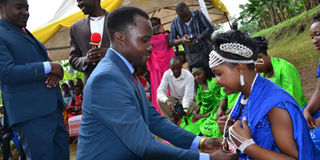Customary marriage the Kitooro way

The bridegroom adorns his bride with beads to show that she is the chosen one. Photos by Scovia Atuahaire.
What you need to know:
Heritage. Like all other tribes, Batooro have a marriage tradition rich with rituals, beliefs and customs that distinguishes it from other tribes
A lot of people are very familiar with the high school drama competition nostalgia, late nights practising the popular lunyegee Ntogoro traditional dance. The dance of boys vigorously showing off their best moves to pursue a girl, and the girls coyly turning away the offer.
But with a little more effort, in the end, the couple would happily walk away hand in hand. This type of traditional dance may not necessarily dig up the best of your high school memories, but it sure depicts the marriage tradition of the Batooro people quite vividly.
Just like in most African traditional cultures, marriage carries a great significance to the people of Tooro. A man is not considered complete until he has found a wife. Batooro have a marriage tradition rich with rituals, beliefs and customs that distinguishes it from other tribes.
“The responsibility of finding a suitor rested upon the parents, with or without the consent of their children,” explains Arthur Namara Alaari, the minister of information and cabinet affairs of Tooro Kingdom. Once the boy’s family found a suitable candidate, they employed a ‘Kibonabuko’ (Go Between). The Kibonabuko’s task was to spy for the family of the girl. Alaari explains that what they wanted to find out basically was the background of the family, their reputation and most importantly if the girl was hardworking.
When this was verified, the Kibonabuko escorted by his kinsmen dressed in the traditional wear accessorised with beaded walking sticks, would come to make their intentions known to the parents of the girl. This ceremony is called ‘Okweranga’ (announcement). “Unlike in other tribes, once the intention to marry a girl was made, Batooro parents sought the consent of the girl before they gave her away,” Araali clarifies.
After the girl agreed, proceedings to negotiate bride price would be instigated. Batooro are divided into two groups, the bahuma and the bairu. The bride price paid by either of these two groups would defer ranging from cattle to agricultural tools like hoes.
More significantly during bride price negotiations, only men were allowed to sit in for the ceremony. “In African tradition, women are married they don’t marry. They were therefore not allowed to sit at the front during these negotiations,” explains Molly Kyakyo Akiki.
She re-counts that, only the young girls of the family are allowed, including the bride, to come out to greet and serve the guests. Even then, these girls were not allowed to wear shoes, look at the men in the face and they were to walk backwards to avoid showing their backs to the men a sign of respect.
The bride price was paid on a ceremony called Okujuka. This was a big ceremony organised by the family of the girl. These served coffee beans as a sign of brotherhood and local beer. It was then that the bride was considered officially engaged to her suitor.
“Before the new age of engagement rings and suit cases of clothes, the family of the groom would send the girl bark cloth and skin hide to make a dress,” Akiki remarks.
In the event of a divorce, the bride price would be refunded to the groom’s family. But if the bride had borne children for the husband, a mere portion of the bride price would be refunded.
Ritual
According to Tom Mboijana, a Fort Portal resident, roasted coffee beans and milk is given to nine people from the bridegroom’s side in a house. This is a traditional gesture of welcoming the bridegroom family. Coffee is served in small baskets while milk is served in milk pots in a ritual knows as okuterura amata.




